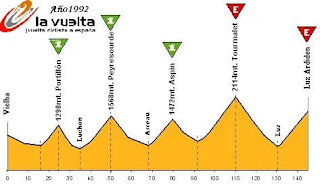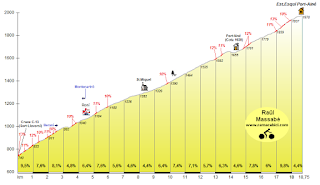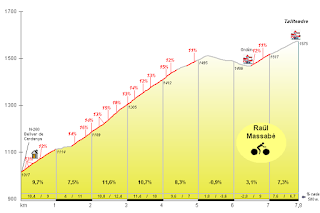 |
| Climbing Coll de Bracons |
Olot is one of the biggest destinations for cycling in Catalan Pyrenees.
Olot is the capital of the vulcanic region of La Garrotxa, an amazing destination with old vulcanoes, very known for local tourism, but not so many for foreigners. But it is absolutely worth to visit.
The choices are so many. The most popular granfondo (sportive) in Catalonia, takes place in a little village close to Olot: Sant Esteve de'n Bas. It is called "Terra de Remences", honoring an historical fact in history of Catalonia.
The double loop in Terra de Remences is fantastic: first loop including Coll de Capsacosta and Coll de Canes, and second loop including Coll de Bracons (steep!) and Coll de Condreu. From Coll de Condreu (a solitaire not-very-steep climb) you can reach Santuari del Far, an amazing place with stunning views. Worth a visit!
 |
| 100% Tondo elevation profile |
But it is not only these clouple of amazing loops that you can do from Olot.There is another granfondo, called 100% Tondo (honouring the catalan cyclist Xavier Tondo who died in a very young age while being professional rider), that starts at Sant Joan Les Fonts (very close to Olot). The final climb of this Granfondo is Vallter 2000, a 1st category climb, included several times in Volta a Catalunya.
 |
| Terrific climb: Collfred! |
From Olot you can also reach a couple of very steep climbs such as Collfred (starting at Sant Privat de'n Bas), which profile you can see attached, and another big (but short climb) is Falgars de'n Bas, with the road in quite bad shape, but also big numbers, very steep climb.
Really close to Olot you can lead to Castellfollit de la Roca, the place to start a couple of very nice (and very steep for some parts) climbs, they are the climb to Oix and Beget (a couple of little villages) through a very nice and quiet road, and the second climb is Colldecarrera, a road through Vall de Bac (Bac valley), with some concrete and supersteep parts. Again, an amazing solitaire road.
Regarding places to stay close to Olot, my favourite place is called El Ferres, a house in Joanetes (starting point of Coll de Bracons). All of our customers love it, and they also love Carme, the lovely lady managing the house, the mum of all the visitors!






















